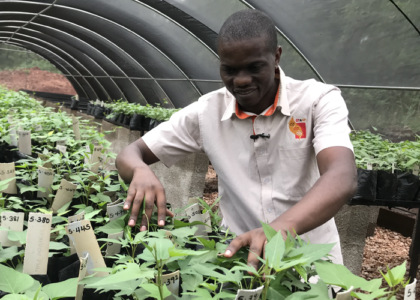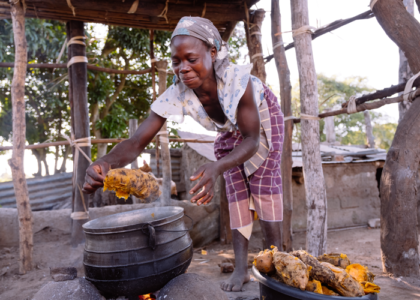
To ensure better adoption of vitamin-A rich sweetpotato, it is paramount to develop varieties that satisfy the needs and desires of both men and women. Whereas men who farm sweetpotato may prefer qualities such as storability and yields, women will tend to favor taste and cookability.
The SweetGAINS project implemented by the International Potato Center and partners is focusing on this question with studies in Mozambique, Tanzania, and Uganda, hoping to gain insights to help strength markets and value chains for sweetpotato, and, in the process, boosting incomes, and food and nutrition security for millions.
“Prioritizing end-user preferences in variety development is a key strategy toward not only enhancing technology adoption, but also bridging the inherent gender technology adoption gap in the developing world,” says Chalmers Mulwa, a social scientist at CIP.
In other words, Mulwa is saying, agricultural research needs to find ways to encourage technology adoption equally among men and women. In the past, the gap has been large in this respect.
In Uganda, women were found to be more widely involved and experienced in sweetpotato production compared to men. Local landraces – Bunduguza and Kasagaati – were the most preferred varieties by farmers in the study area. These varieties were said to be popular due to various preferable traits such as good taste, high dry matter content, and long underground root storage that allows piece-meal harvesting. Women also preferred agronomic traits such as high yields and drought tolerance. Men, on the other hand, only preferred agronomic traits such as yield and storability.
“We have worked on some varieties for years only to see them fail in the market place. But now we know these preferences by gender, and we can breed accordingly,” Mulwa says. “Knowing these preferences can help us solve the puzzle of low market penetration of improved varieties.”

In Mozambique, results indicated that men and women sweetpotato producers and consumers showed a wide range of preferences. Women producers preferred varieties rich in vitamins and good taste, while men looked for disease-resistance and drought tolerance. On the consumer side, both men and women preferred varieties with a high dry matter content, good taste and high vitamin content. Women specifically wanted sweetpotatoes that were easy to cook.
A study in two counties in Tanzania found that consumption of sweetpotato in urban and sub-urban areas had increased in the last five years. While consumer and producer preferences were similar to those found in Mozambique and Uganda, researchers noticed that women tended to grow more varieties than men, including those with low market demand but considered beneficial to a family’s well-being. These varieties possessed positive traits such as big root size, high dry matter content, high yields and good taste. On the other hand, men focused on varieties with a high market demand.
Taken together, these three studies illustrate the need for gender-disaggregated preference testing with sweetpotato and other crops.
“Insights from these rapid assessment studies have provided necessary evidence for the need for demand and gender-responsive breeding systems to increase the adoption of improved sweetpotato varieties by targeted customers. This is one major link in the sweetpotato value chains that is essential for ensuring better incomes and nutrition for millions of African families,” noted Mulwa.
